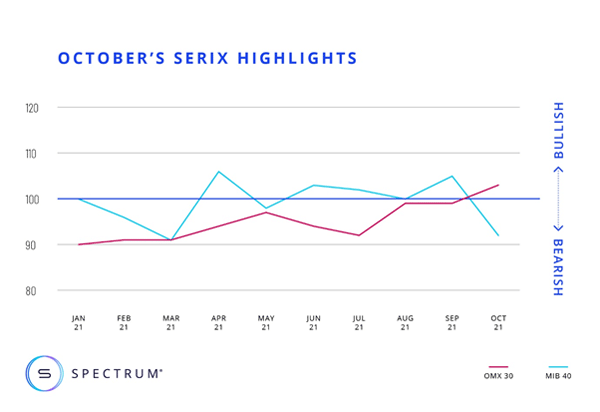- Bearish SERIX sentiments on all other European and US indices in October
- Positive economic data may have contributed to bullish sentiment on OMX 30
- Record 80 million securitised derivatives were traded on Spectrum last month
Spectrum Markets, the pan-European trading venue for securitised derivatives, has published its SERIX European retail investor sentiment data for October (see below for more information on methodology), which recorded bearish views on all indices except Sweden’s OMX 30.
The positive sentiment on Sweden was all the more remarkable for being the first time its SERIX value has moved into bullish territory this year, reaching 103 in October. By comparison the other European indices ranged between 88 (IBEX 35) and 99 (FTSE 100), and 93 (S&P 500) and 98 (DOW) for the US indices.
Italy, in particular, led the way on bearish change in sentiment with SERIX for the MIB 40 recording the most significant shift among the indices, dropping from 105 in September to 92 in October. This came in spite of many key economic indicators suggesting the country is recovering well from the pandemic.
“We’ve seen positive sentiment building steadily throughout the year for the OMX 30, from a low of 90 back in January, but it is still surprising to see it as the only bullish outlier in sentiment across all the indices,” notes Michael Hall, Head of Distribution, Spectrum Markets.
“October didn’t start so well for Sweden, with GDP data released at the start of the month revealing its economy shrunk by 3.8% in August, well over what many analysts had expected. But overall it seems to be recovering well from the pandemic, and preliminary data for Q3 that came out last week suggests better than expected growth compared to Q2.
Sweden’s COVID vaccination programme is so far outpacing the rest of Europe, and the country now boasts an 80 percent vaccination rate and an 55 new cases per 100,000 of the population. Meanwhile all over-65s are being offered booster vaccinations, and the government has been able to lift all pandemic related restrictions. Music or sport events can be enjoyed without checkpoints, masks or tests.
There appears to be a sense of optimism building for this market which is reflected in its SERIX turning bullish for the first time this year, though looking ahead investors will no doubt be watching closely for signs that Sweden’s central bank is preparing to take action to curb the country’s rising inflation,” added Hall.
During October, a record 80 million securitised derivatives were traded on Spectrum, with 34.6% of trades taking place outside of traditional hours (i.e. between 17:30 and 9:00 CET). 87.3% of the traded derivatives was on indices, 6.7% on currency pairs, 4.9% on commodities, and 1.1% on equities, with the top three traded underlyings being DAX 40 (21.8%), NASDAQ 100 (20.6%) and OMX 30 (20.4%).
Looking at the SERIX data for the top three underlyings, alongside OMX 30, the DAX 40 turned slightly bearish again, moving last month 102 to 98, while the NASDAQ 100 lost some of the bullish momentum it started building in June, dropping from 102 to 97.

Calculating SERIX data
The Spectrum European Retail Investor Index (SERIX), uses the exchange’s pan-European trading data to shed light on investor sentiment towards current development in financial markets.
The index is calculated on a monthly basis by analysing retail investor trades placed and subtracting the proportion of bearish trades from the proportion of bullish trades, to give a single figure (rebased at 100) that indicates the strength and direction of sentiment:
SERIX = (% bullish trades - % bearish trades) + 100
Trades where long instruments are bought and trades where short instruments are sold are both considered bullish trades, while trades where long instruments are sold and trades where short instruments are bought are considered bearish trades. Trades that are matched by retail clients are disregarded. (For a detailed methodology and examples, please visit this link).




.jpg)



